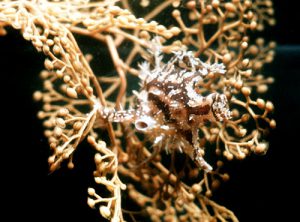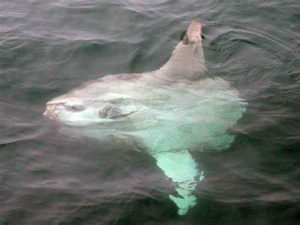Is this what it sounds like? Fish that do not swim, but drift? Well… yes and no. They can swim, just not very well – they do better by drifting.
The word used most often for any drifting creature in the sea is plankton. Plankton literally means “drifter” or “wanderer”. Most plankton, including planktonic fish, can swim. Some can adjust their position in the water column – rising near the surface at night, sinking deeper during the day.
When you think about it, it is a cool way to make a living out there. With miles and miles of open blue water, the swimming fish must keep swimming. To do this requires a lot of energy, open water fish must consume a lot of high energy food. Drifters just drift. Hang with the currents, enjoying the moment, eating what they can. Sounds pretty good huh?
As you can imagine, there are not many fish who live this lifestyle. Many do after they hatch in their larval stage – but as adults, most live on the bottom, others in the open blue. Let’s meet a couple of the drifters.
Sunfish
Now here is one weird looking fish. Large bulbous head, long angular dorsal and ventral fins, and no tail – it’s a swimming/drifting head. These large open water drifters can reach seven feet long, seven feet high, and weigh over a ton. They can hold their position, undulating their dorsal and ventral fins, and move slowly through the water. Often, they will turn on their sides and just hang there. Looking like a floating board or something, small creatures are attracted to them, some of which they eat. Their diet is primarily jellyfish, though they have been known to take small fish, crustaceans, and even algae.
They are related to puffer fish, and actually resemble them early in life, but the resemblance fades quickly as this becomes more head than anything else.
Though rarely seen near shore, they have been, and one was actually spotted inside Pensacola Bay. They occasionally wash ashore dead. One did on Dauphin Island. The staff at the Sea Lab made a mold of the dead creature which is now hanging in the public Estuarium there. Many know this fish by its scientific name – Mola mola – or simply “the mola”. It is a pretty cool fish.
https://www.montereybayaquarium.org/animals/animals-a-to-z/ocean-sunfish/

This sargassum fish is well camouflaged within this mat of sargassum weed.
Photo: Florida Museum of Natural History
Sargassum Fish
Sargassum fish are members of a family known as “frogfish” – so you can guess what they must look like – and can guess they are not real good swimmers. Almost completely round, they are blobs in the sea. There are three species in the Gulf, two if which are bottom fish. However, the Sargassum fish is a drifter – drifting with the common seaweed known by its scientific name Sargassum. Sargassum is brown algae that produces air bladders called pneumatocyst. These bladders allow the weed to drift in large mats at the surface where they get sunlight. Some sargassum mats are huge is size and are an ecosystem amongst themselves. Hundreds of miniature fish and invertebrates call this place home – a place to hide in the open sea. It is the home of baby sea turtles, if they can make the trek from the beach alive.
One member of this community is the Sargassum fish (Histrio histrio). It has the typical frogfish shape and look but the coloration matches the Sargassum weed perfectly. Like other frogfish, the first dorsal spine is modified into a “fishing rod” complete with a “lure”. When prey (small creatures in the Sargassum weed) are in view, the Sargassum fish will extend the illicium (as it is called) and actually move it back and forth to make it look like live bait – they are fishing.
Most members of the Sargassum community flee the weed when the currents bring it to close to the beach. However, they hang on longer than you might think. If you are at the beach when the Sargassum is drifting just off the shore – wade out with a small kids dip net and snag a patch. Place in a bucket and see who comes out. You MIGHT get lucky and catch one of these ocean drifters.
- Our Environment: Part 11 – We Need Water - July 7, 2025
- Our Environment: Part 10 – Improving Agriculture - June 20, 2025
- Marine Creatures of the Northern Gulf – Snails and Slugs - June 20, 2025

